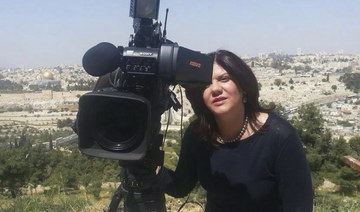DUBAI: Veteran Palestinian American journalist Shireen Abu Akleh was most likely shot by an Israeli soldier from an elite army unit, a monthlong investigation by The New York Times has concluded.
The Al Jazeera reporter was killed on May 11 while covering an Israeli military operation in the occupied West Bank. Last week, the news network published an image of the bullet that it says killed its reporter, and identified it as a US-made 5.56mm round fired from an M4 rifle, a weapon commonly used by Israeli forces.
Israeli officials said a soldier might have shot Abu Akleh by mistake but also suggested the bullet might have come from a gun fired by a Palestinian. A preliminary investigation by the Israeli Army concluded it was “not possible to unequivocally determine the source of the gunfire.”
However, the investigation by The New York Times found that the bullet that killed the reporter was fired from the approximate location of an Israeli military convoy, most likely by a soldier from an elite unit.
It ruled out the Israeli suggestion that a Palestinian gunman might be responsible because there were no armed Palestinians near Abu Akleh when she was shot. The report also revealed that 16 shots were fired from the location of an Israeli convoy, contradicting Israeli claims that the soldier fired five bullets in the direction of the journalist.
The Times investigation did not find any evidence “that the person who fired recognized Ms. Abu Akleh and targeted her personally,” and was “unable to determine whether the shooter saw that she and her colleagues were wearing protective vests emblazoned with the word ‘Press.’”
The investigators pieced together the events of the day leading up to the shooting using videos collected from bystanders, journalists and security cameras; interviews with seven witnesses; the Israeli military’s accounts; audio analysis carried out by experts; and four visits to the site by Times reporters.
The killing of Abu Akleh and subsequent attacks by Israeli forces sparked an international outcry. A number of global media outlets, including CNN, The Washington Post, the Associated Press and investigative group Bellingcat, have conducted separate investigations into the reporter’s death, all of which concluded that Israeli forces were responsible.














